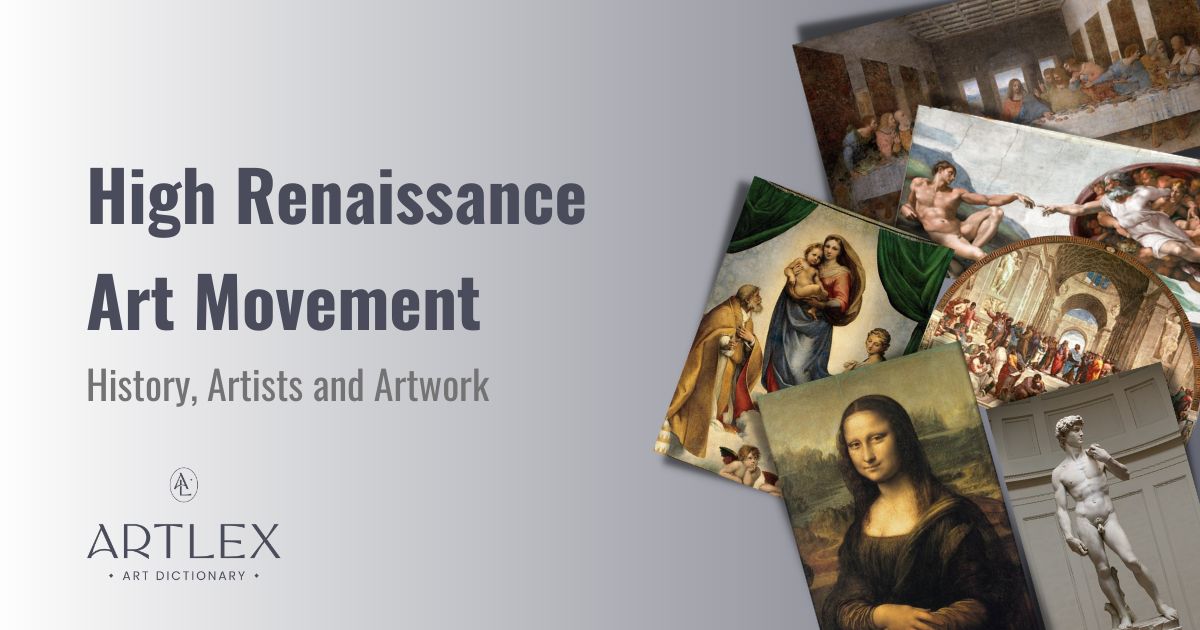What is High Renaissance Art?
High Renaissance art is defined as painting, sculpture, architecture, and other decorative arts created, during Renaissance period, between 1490-1527. The rebirth of classicism, and an appreciation of the classical learning of ancient Greek and Rome as practiced by earlier Renaissance artists continued, with Renaissance art reaching its greatest heights.
Notable High Renaissance Artwork
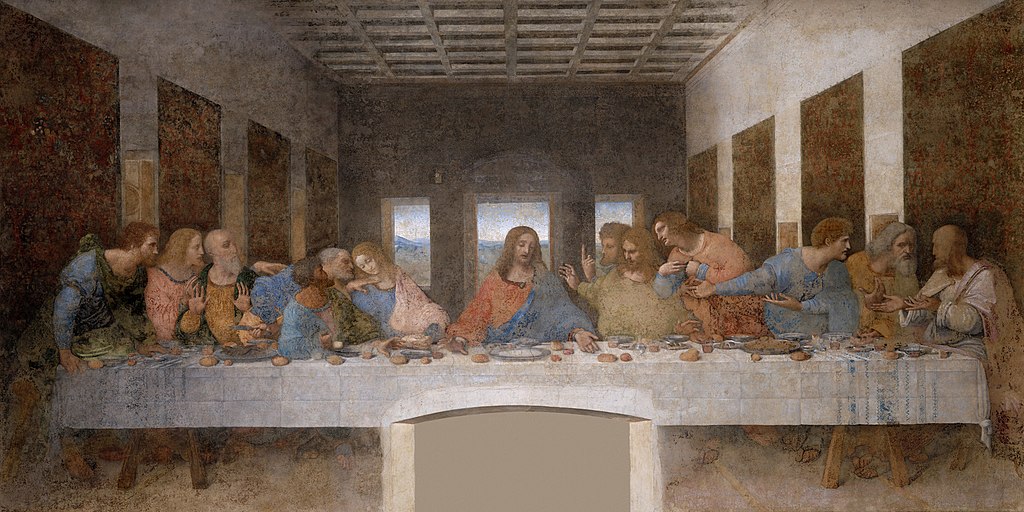
https://legraziemilano.it/ultima-cena/
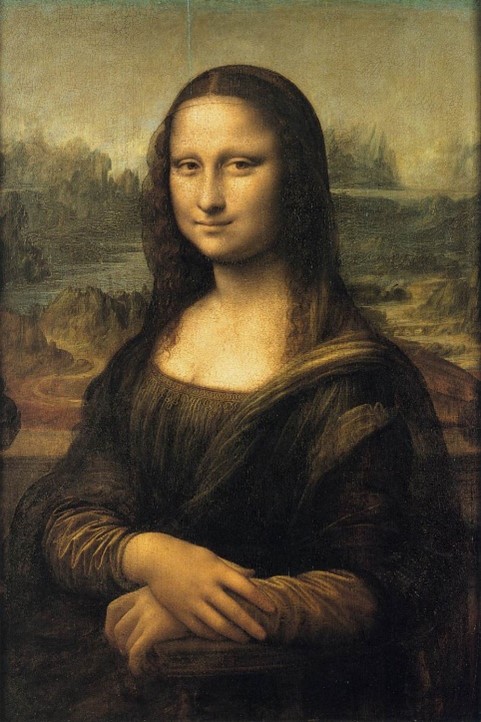
https://collections.louvre.fr/en/ark:/53355/cl010062370
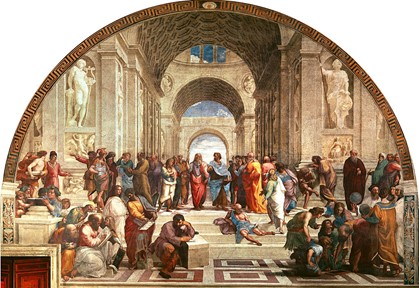
https://vatican.com/Raphael-rooms-Vatican-museums/
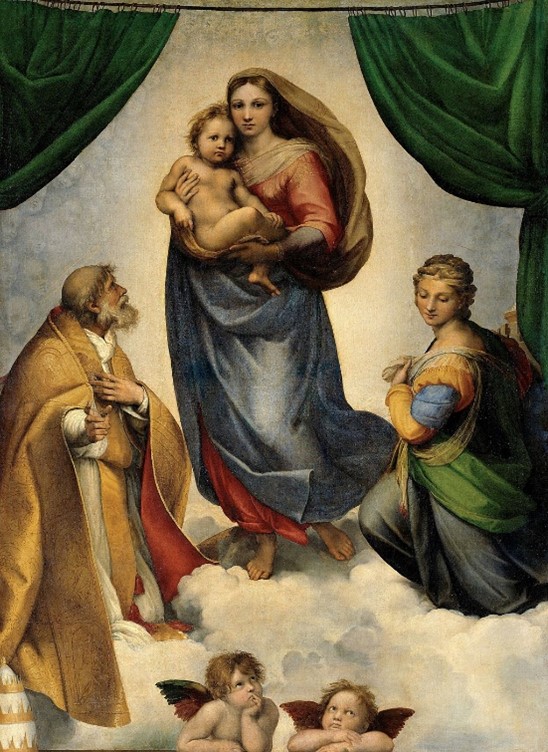
https://gemaeldegalerie-skd-museum.translate.goog/ausstellungen/die-sixtinische-madonna/?_x_tr_sl=de&_x_tr_tl=en&_x_tr_hl=en&_x_tr_pto=sc
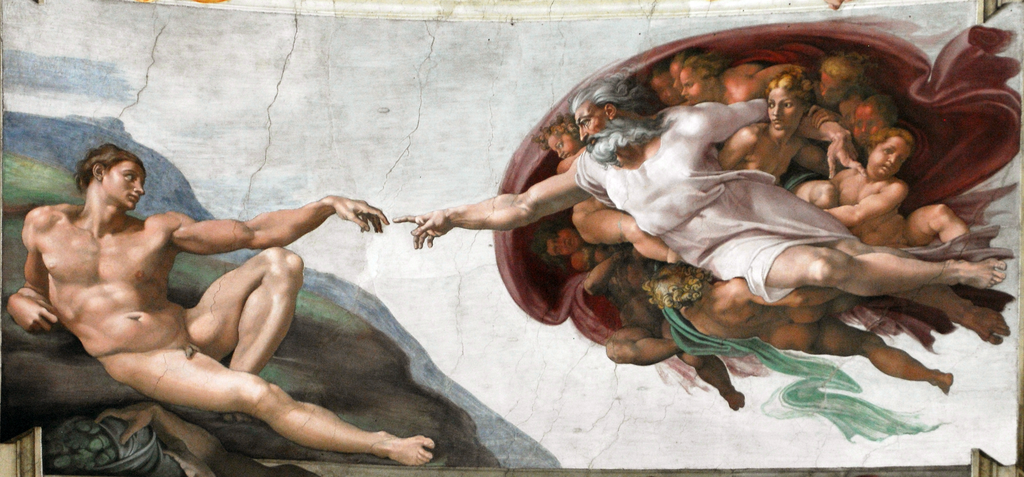
https://www.museivaticani.va/content/museivaticani/en/collezioni/musei/cappella-sistina/volta/storie-centrali/creazione-di-adamo.html
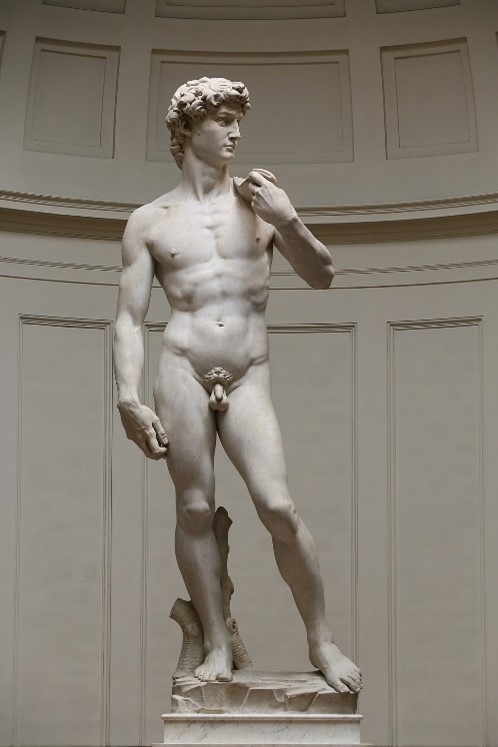
https://www.accademia.org/explore-museum/artworks/michelangelos-david/
The History and Expansion of Renaissance Art
Early Renaissance art began in Florence starting in 1401, where two ruling families the Medici and the Pazzi family were competitors and vast patrons of the arts. The influence of this art spread throughout Rome, Naples, Sienna and Venice. Northern Renaissance (1430-1580) art flourished in France, Belgium (Flanders), Holland, Germany and England.
The Beginning of High Renaissance Art
High Renaissance art (1490-1527) was centered in Rome and the city drew the finest High Renaissance artists. This was a culmination of the Renaissance period, and it was now at its greatest heights. Works still referenced classical art. Religious art was commissioned most notably by Pope Julius II, who understood classical antiquity.
Art historians consider three Italian Renaissance artists to be dominant forces during this period: Leonardo da Vinci (1452-1519), Michelangelo (1475-1564) and Raphael (1483-1520). These High Renaissance painters changed the course of art history and encapsulated the work of High Renaissance artists.
Artist Leonardo da Vinci completed painting The Last Supper (1495-98); Mona Lisa (1503-05); and The Virgin of the Rocks (1485) during the High Renaissance period
Michelangelo was an architect and sculptor who had just learned to paint when he received the commission to paint frescoes in the Sistine Chapel, in Rome. Of the works he created here, one of the most famous The Creation of Adam (1508-1512) is painted on the Sistine Chapel ceiling.
Raphael completed paintings including The School of Athens (1511); Sistine Madonna (1512), and Transfigurations (1520).
What are the Characteristics of High Renaissance Art?
Some of the characteristics of High Renaissance period art include linear perspective, trompe l’oeil to incorporate elements of architecture, the hazy effects of sfumato and quadrature or ceiling paintings.
Leonardo da Vinci’s grasp of science and mathematics, along with his artistic abilities culminated in Vitruvius Man (1490), a drawing which illustrated ideal male proportions and helped other artists to create accurate depictions of human form and anatomy.
The main goal of Renaissance art was beauty and an overall pleasing esthetic through composition.
High Renaissance Painting
High Renaissance artists during this period began to move from tempera to painting with oils.
Leonardo da Vinci favored the use of chiaroscuro but with a lighter hand. He invented sfumato enabling him to blend tones and colors gradually which softened outlines.
Leonardo da Vinci used the sfumato technique when painting Mona Lisa, the oil on panel portrait that now hangs in the Louvre. Mona Lisa is arguably the most famous painting in the world. Leonardo da Vinci worked on continually to perfect this High Renaissance painting.
His work Last Supper, a fresco secco, in situ, was painted in a mix of oil and tempura, on the wall of the Santa Maria dell Grazie, in Milan Italy. Leonardo da Vinci divides his compositions into groups of three, indicating the trinity, or fours based on Plato’s virtues of wisdom, courage, moderation, and justice. Chiaroscuro is used to round out figures, while sfumato gives a hazy effect. An element of humanism is brought to the work by the elimination of halos in this High Renaissance painting.
To join humanistic thought with Church teachings, Pope Julius II commissioned Italian Renaissance painter Raphael to create a buon fresco in the library in the Papal Apartments, at the Vatican Palace, in Vatican City. The School of Athens contains 50 classical figures. The scene of this Renaissance painting is set in ancient Greece under the arch of a large Basilica, complete with Roman sculptures of both Apollo and Athena.
In this masterpiece of disegne, or Italian fine art drawing, Raphael uses linear perspective to create the illusion of depth. A Renaissance color palette is employed for beautification and meaning. Chiaroscuro is used to show figures in three dimensions.
Plato and Aristotle provide the divisional lines of philosophy in the composition. Plato points upward signifying the cosmos, while Aristotle points downward denoting his connection to that which is earth bound. Figures on either side of the two men represent an alignment of philosophy in this High Renaissance painting.
At the same time, also at the Vatican, Michelangelo was painting the crowning glory of the Sistine Chapel–the ceiling frescoes. The nine in the center are the most important comprising three narratives, each depicted in a trio of works: Creation of Heaven and Earth; and The Creation of Adam and Eve and the Expulsion from the Garden of Eden; and Noah and the Great Flood.
Each of these works is separated by painted architectural framework that looks real. The artist achieved this by using Trompe l’oeil, the French illusionistic painting technique that tricks the eye.
Male nudes, known as ignudi, sit across the center of the work. Sibyls and prophets, who foretold the coming of Christ line the edges.
Michelangelo first painted in grisailles or grays to achieve shadows and depth of figures before adding color to his works at Sistine Chapel. The result is figures that look almost sculptural. A recent cleaning of the frescos at Sistine Chapel revealed the original jewel tones highlighting the artist’s ability as a colorist.
The Venetian Painters
High Renaissance Venetian painters were known for their luminous colors using oil paints. Italian Renaissance painter Giovanni Bellini (1430-1516) was considered the biggest influencer on Venice’s primary Renaissance painters of the Venetian school. He brought humanistic qualities to religious art, while creating detailed landscapes or even interior architectural elements as part of his composition. In The Sacred Conversion, an altarpiece (1487) Bellini paints the Virgin Mary in conference with saints, set inside a Venetian church, instead of the heavens.
Other Venetian High Renaissance artists such as, Giorgione (1477-1501), Titian (1488-1576) and Lorenzo Lotto (1480-1556) learned a lot from the master.
Giorgione perfected landscapes and the creation of texture and light in works such as Pastoral Concert (1510). Giorgione was a master of the Venetian school. His student Titian would become a major figure with works including Assumption of the Virgin (1518), Sacred and Profane Love (1515), The Entombment of Christ (1523) and the Pesaro Madonna (1526). Titian would draw out his compositions before painting with both a brush and his fingers. Lorenzo Lotto’s paintings were known for rich color and bold shading containing hidden messages such as in Andrea Odoni (1527). Not as popular as Titian, he found much of his work outside of Venice.
High Renaissance Sculpture
Michelangelo was the master of High Renaissance sculptor favoring marble to create works such as Pietà (1498-1499), the iconic High Renaissance sculpture David (1501-1504), which stands 13 feet and 5 inches tall, originally made for the Cathedral in Florence and commissioned by the Opera del Duomo. Michelangelo depicts David concentrating. The High Renaissance sculpture is a masterpiece of human form.
Moses (1515) was commissioned in 1505, by Pope Julius II for the monumental project of sculpting works for his tomb. It was meant to have 47 life sized sculptures, including a portrait of the pope all based on classical sculpture. After the pope died in 1513, the project was downsized and not completed until 1545. Moses is Michelangelo’s most lifelike sculpture, with protruding veins and tendons. The cloth of the fabric is heavily folded and pleated just like classical sculpture.
Michelangelo was known to sketch out countless drawings of a High Renaissance sculpture before beginning. He drew his inspiration from classical Greek and Roman sculptures, while also studying cadavers for complete accuracy of human form.
Architecture
Donato Bramante (1444-1514) was the most famous architect during the period of the High Renaissance. Pope Julius II was his top patron. Bramante was the pope’s chief architect and engineer, in a plan to rebuild the city.
St. Peter’s Basilica
Julius II commissioned Bramante to first demolish St. Peter’s Basilica, that had been built by Emperor Constantine the Great in the 4th century. Then, he needed to rebuild it. Bramante purposed a central plan based on a square, with a Greek cross, or cross of equal sized arms, running through the center. A large dome was to be constructed in the center, with smaller domes radiating out. This classical form of architecture influenced by ancient Rome was highly popularized in High Renaissance architecture.
Work began on the project in 1506. With the death of Bramante in 1514, Raphael and Fra Giocondo started a redesign, but this was not completed. Upon Raphael’s death the job was left to Michelangelo who designed the dome and crossing, while eliminating the nave. With his passing in 1564, the original plan was extended, a nave was added and a grand façade. The project was fully complete in 1626.

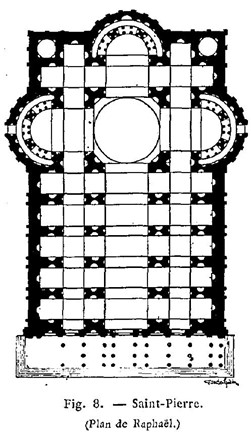
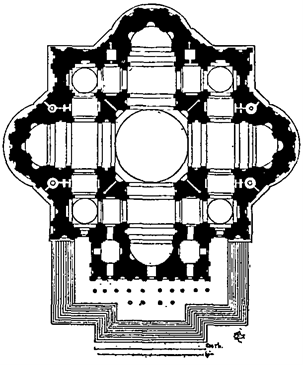
Belvedere Courtyard
Meanwhile, in 1505, Bramante was commissioned to design Cortile de Belvedere, or Belvedere Courtyard, a space of 1000 feet between Villa Belvedere and the Vatican Palace. To walk from the palace to the villa one had to walk uphill. This was eliminated by terracing the land on three levels and building a series of staircases. Bramante also designed wings along the side to allow for walking in bad weather.
The entire project was based on the architecture of ancient Rome. Here Julius II collected ancient Roman statues for the garden. When Bramante died in 1514, the work was finally completed by Pirro Ligorio between 1562-1565.
The courtyard design, gardens and piazzas gained fame across Europe. Today Belvedere Courtyard represents a significant achievement in High Renaissance architecture.
Decline of High Renaissance Art
Julius II died in 1513, and Michelangelo spent his time sculpting his tomb, before returning to Florence to work for the powerful Medici family. Leonardo da Vinci continued to perfect the Mona Lisa while working on numerous projects that remained largely unfinished. Most of Raphael’s time was spent on St. Peter’s Basilica.
Leonardo da Vinci died in 1519, followed by the young Raphael shortly after. In 1927 the Medici family were expelled from Florence and Rome was sacked by Emperor Charles V. Humanism was cast aside while religious battles raged.
High Renaissance Artists
- Leonardo da Vinci (1452-1519) Italian
- Raphael (1483-1520) Italian
- Michelangelo (1475-1564) Italian
- Giovanni Bellini (1430-1516)
- Giorgione (1477-1501)
- Titian (1488-1576) Italian
- Lorenzo Lotto (1480-1556) Italian
- Donato Bramante (1444-1514) Italian architect
Art History Related Terms
- Renaissance Art
- Buon Fresco
- Contrapposto
- Chiaroscuro
- Disegno
- In Situ
- Linear perspective
- Loggia
- Fresco Secco
- Grisailles
- Ignudi
- Sfumato
- Trompe l’oeil

